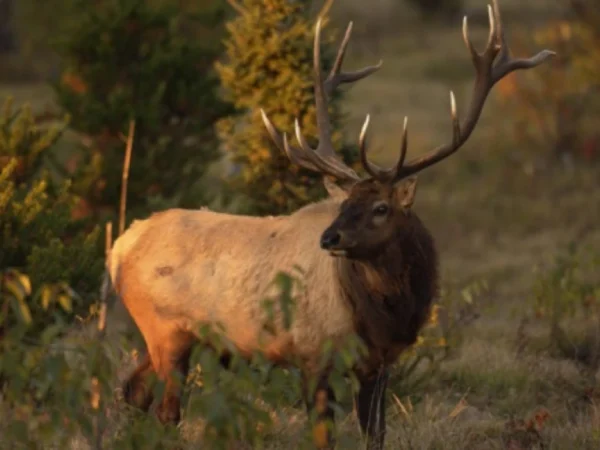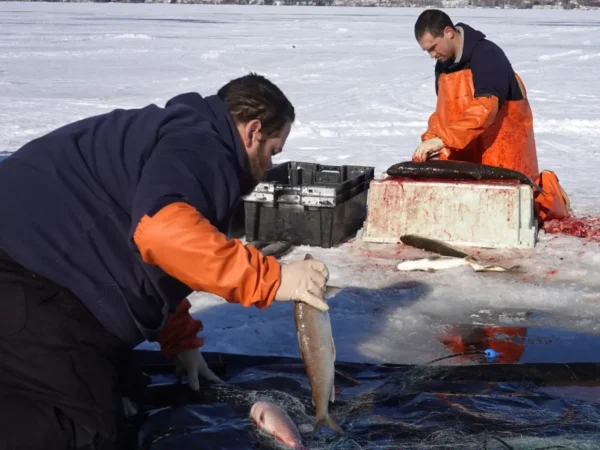
Great Lakes Moment is a monthly column written by Great Lakes Now Contributor John Hartig. Publishing the author’s views and assertions does not represent endorsement by Great Lakes Now or Detroit Public Television.
The National Oceanic and Atmospheric Administration (NOAA) reported that February 2023 was Earth’s fourth-warmest on record. In the Great Lakes basin, this is being witnessed through less lake ice cover, which is already having major impacts.
Greenhouse gas emissions from human activities are the leading cause of the Earth’s rapidly changing climate. As of February 13, 2023, only seven percent of the Great Lakes were covered in ice, which is significantly below the 35-40 percent ice cover expected for that time of year, according to NOAA’s Great Lakes Environmental Research Laboratory.
Although the lack of ice cover on the Great Lakes this winter has been helpful in the shipping world, it causes many ecosystem problems.
Lower ice levels on the Great Lakes leaves coastal areas less protected from strong winter storms and waves that can increase coastal erosion and damage lakefront properties. This erosion can, in turn, lead to excessive sedimentation problems and even severe flooding. In contrast, lake ice cover helps minimize erosion and protect lakeshore properties and developments.
Another impact of less Great Lakes ice cover is extreme weather, as evidenced by the increasing intensity and frequency of heavy rainfall and snowfall. Without ice cover on the lakes, wind moves over the open water, picks up moisture and often deposits it in heavy precipitation events called “lake effect.”
For example, a major lake effect storm occurred on December 23, 2022 in the Buffalo, New York area. A record daily snowfall of 22.3 inches was set at the Buffalo Airport. This historic blizzard and lake effect snow event led to widespread power outages, impossible travel, school and government closures and the loss of lives in Niagara and Erie counties.
The lack of Great Lakes ice cover also prohibits or severely limit ice fishing, which is cultural in many areas. For example, the ice fishing harvest of species like lake whitefish, panfish, bass, walleye and yellow perch was high in nearshore areas during the 3-4-month periods of cold winters in 1996, 2009, 2014, and 2015 when ice was thick. In contrast, ice fishing harvest is low when ice cover is low and unstable.
Related:
- Breaking Up: Ice loss is changing one Anishinaabe fisherman’s relationship with Lake Superior
- On Michigan’s inland lakes, ice fishing with less ice, and fewer fish
We also know from fishery biologists that thick, stable ice protects fish eggs that incubate over winter and increases their survival. Lake ice serves as a protective barrier from waves for fish eggs and the number of young fish that survive to enter the adult population is known to be higher after cold winters than during warm winters.
In contrast, fish that spawn and rear in Great Lakes tributaries, such as steelhead, suffer higher mortality during cold winters than in warm winters and their production of juvenile fish, called smolts, is reduced. Long, cold winters are known to cause die-offs of fish species like alewife, which are not native to the Great Lakes.
We know from scientific laboratory studies that cool-water fishes such as yellow perch require an extended period of cold temperatures during winter to fully develop their eggs and provide newly hatched larvae with adequate fat reserves that will sustain them until they can find food. Long-term records from 1973–2010 show that the number of young yellow perch that survive to become adults in Lake Erie is low following short, warm winters.
In addition, fishery biologists have noted that during short winters, females spawn at warmer temperatures and produce smaller eggs that both hatch at lower rates and produce smaller larvae than females exposed to long winters.
Related:
- Lake Superior Winter: Researchers belatedly turn their eyes to the impact of warming winters
- Four ways Great Lakes winters are changing as scientists search for clues
Lack of Great Lakes ice cover during mild winters will also result in the resuspension of nutrients like phosphorus and nitrogen from sediments in nearshore and shallower areas. This may contribute to summer algal blooms. In contrast, ice cover allows these nutrients to settle out at the bottom of the lakes.
Great Lakes scientists are concerned that winter ecology is a major knowledge gap, and are now developing studies to better understand the importance of winter — and ice — to Great Lakes ecosystems.
“We know that lower Great Lakes ice cover will increase coastal erosion, the frequency of extreme weather, and resuspension of nutrients that may contribute to summer algal blooms, yet there is much uncertainty in terms of climate simulations,” said Dr. Mike McKay, director of University of Windsor’s Great Lakes Institute for Environmental Research. “The Great Lakes will continue to warm over the next several decades and despite year-to-year variability, Lake Erie is trending towards an ice-free status during the winter months. Even though we have seen the lakes bounce back from adversity before, less ice cover will be a new normal.”
Catch more news at Great Lakes Now:
Great Lakes Moment: The event that saved Humbug Marsh
Great Lakes Moment: A community science survey
Featured image: MODIS satellite photograph taken of the Great Lakes on March 8, 2023. (Photo Credit: National Oceanic and Atmospheric Administration)
1 Comment
-
“The new normal” is nothing more than a wild guess. This year was one of the lightest ice covers on record, yet in Door County, Wisc., there was still ice fishing in some of the bays and harbors the first weekend of April after a cold, snowy March. Additionally, we had back-to-back cold winters a decade ago in which Lake Superior froze completely over and — for a day — Lake Michigan almost did, something that has happened maybe once in the past century. If anything, wild fluctuations seem to be the new norm.




